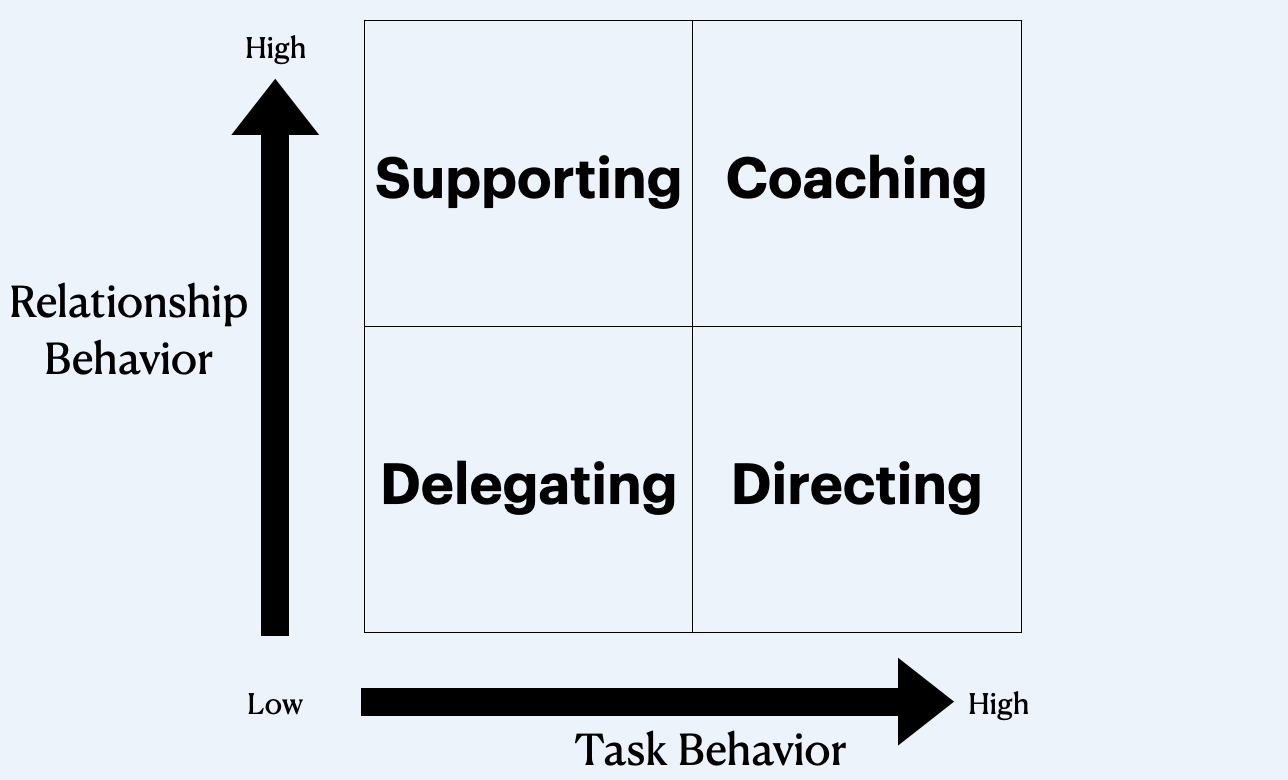Engineering MBA
Apply To Graduate 🔗
Congratulations on completing your coursework. To receive your diploma, please fill out the form below.
Presentation Resources 🔗
- Video
- Slides
- Proposal
- Blog Post: Situational Leadership
- Blog Post: Competitive Advantage
- Blog Post: Core Competency
- Blog Post: Business Process Management
Curriculum 🔗
Situational Leadership 🔗
The Situational Leadership Model posits that there are four different styles of leadership.
- Directing - provide close, detailed supervision with clear instructions and expectations.
- Coaching - focus on getting buy-in from the team on explaining why decisions are made the way they are.
- Supporting - shift decision-making ownership to the team and facilitate discussion amongst the team to reach decisions and provide encouragement.
- Delegating - focus on overall vision, trusting the team with autonomy on day-to-day decision-making.
A leader must be able to exhibit all of these styles. Otherwise, they’ll only be effective in very specific scenarios with a very specific group of people at a given time. In order to determine which style to use at a given time, consider how much relationship and task behavior is required by the individual or team at the moment.

Consider this model when you’re in a position of leadership, or to identify what type of leadership you or your team would benefit from at the moment. Sprint planning exercises are an opportunity to understand how different leadership styles can benefit different people on a specific task.
Competitive Advantage 🔗
A firm’s competitive advantage is the attributes that allow it to flourish against competitors. There are three general competitive strategies:
- Cost.
- Differentiation.
- Focus.
Core Competency 🔗
A firm’s core competencies are the very specific set of qualities or characteristics that drive success. A core competency must meet all of the following criteria:
- Provides access to various markets.
- Contributes to perceived customer benefit.
- Difficult for competitors to imitate.
Identification of core competencies can aid in more quickly answering your next build vs. buy vs. borrow conundrum when building out a feature.
Business Process Management 🔗
Dr. Thomas Davenport defines a process as:
a structured, measured set of activities designed to produce a specific output.
The Association of Business Process Management states that Business Process Management
enables an enterprise to align its business processes to its business strategy.
Managing and delivering iterative improvements of a business process involves following these cyclical steps:
- Design - document the existing process and propose an improved future state.
- Model - perform “what if” analysis to subject different theoretical constraints to the proposed future state.
- Execute - in an automated or manual fashion, roll out the future state to a small group.
- Monitor - track and report on key performance indicators (KPIs) to observe the impact of the change.
- Optimize - identify current bottlenecks and feed that in to future design iterations.
Business Process Reengineering 🔗
Reengineering is the big rewrite of processes. The process is reimagined from the ground-up, ensuring that each step in the flow directly contributes to the intended goal and adds value.
Much of our work as software developers involves managing processes. Whether we’re optimizing our individual developer workflow, or automating business processes, we can follow the same methodical approach to know if we’ve succeeded in improving stakeholders’ well-being.
Ensure that the ultimate focus is not purely on solving the optimization problem - consider the impact and consequences of the work being delivered for users of the system and those otherwise impacted by the decisions made by the system.
Dr. Hammer, credited with introducing the concept of Business Process Reengineering, later stated that,
I was reflecting my engineering background and was insufficiently appreciative of the human dimension.
Dr. Davenport, who provided our definition of a process above, also remarked,
The rock that reengineering has foundered on is simple: people.
Consider the consequences of our work. Not only for the team building the system, or using the system, or that uses its output. Consider the impact on systems and individuals who are affected by the decisions your system makes who don’t even know your system exists.
Extra Credit Reading 🔗
- Getting To Yes: This is a seminal read on negotiation tactics. If you’ve heard of BATNA, best alternative to a negotiated agreement, this is where that comes from.
- Reengineering the Corporation: Our coursework introduces the topic of Business Process Reengineering. If you’d like to dig in further, this is the book to pick up.
- Blue Ocean Strategy: If you’re interested in how to explore different strategies for a successful business, I recommend reading this.
- Good to Great: This is a fascinating dissection of the characteristics and qualities that define successful companies over the long-term.
- Essentials of Business Communication: I’m only familiar with the 7th edition of this textbook, but it’s a reference I continue to use today when I need to structure a certain kind of written business report or communication.